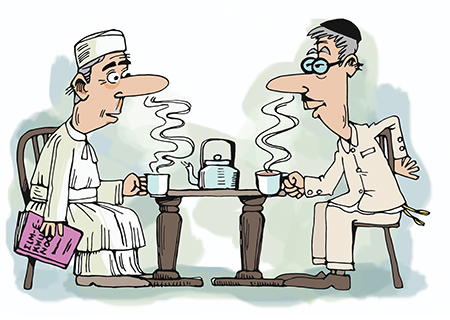The saints
Berjis Desai
At first blush, Navsari may have appeared hedonistic: gorging on mutton and mullets, garish pink super sweet ice cream and deep fried crunchy pastries; guzzling toddy and hooch distilled at home; and indulging in six-day wedding feasts. However, it had its fair share of saints who led a spartan life of service and learning. Two of them were best friends. We shall call the priest, Edul, and the school teacher, Dinyar. Not related, they were born, and died, within months of each other — as if the cosmic force had sent them on a joint mission.
After the birth of his two daughters in quick succession, the priest remained celibate in thought, word and deed. Women found his bachelor friend’s eyes so pure, as if desire did not even emanate within him. Edul was a ninth-generation ordained priest who, as a lad of 13, had participated in the consecration of the new Towers of Silence at Navsari and recited nearly two lakh Atash Neyayeshs in his long life before the holy fire, very much a living entity for him. For students of esoteric Zoroastrianism, the significance of reciting the extremely potent para from the Atash Neyayesh: "Usmoi uzareshva Ahura” nine times for every boi he performed, is unbelievable. Their navar ceremonies were performed at India’s oldest agiary, the Vadi Dar-e-Meher in Dastur Vad, consecrated more than 880 years ago.
Academically brilliant, despite abject poverty Dinyar did an MA in history but preferred to serve the local boys’ school in Navsari, spurning offers to be a lecturer at Bombay University. Barring his youngest sister married in Navsari to a vendor of fruits (called mej), his other siblings were scattered in Calcutta, Delhi, Bombay and even Karachi. When his sister was widowed young, he vowed to look after her three children and eschew marriage. Despite his docile and calm personality, a respectful silence descended instantly when he entered a boisterous classroom. Like his priestly friend, he too was soft spoken to the point of inaudibility.

Illustration by Farzana Cooper
The teacher supplemented his meager income by giving tuitions — free or at ridiculously low fees. His friend taught at the Dadar Athornan Madressa in Bombay for a while and then retired to his hometown to tend his beloved fire at another ancient agiary, just 100 steps from his modest residence from which his industrious wife sold sandalwood sticks and wove a kusti every other day (delivered at Surti ni dukaan which sold it after adding a modest margin). And what was the use of money anyway? The friends ate the simplest of vegetarian meals; never ate at a restaurant and were members of no club; wore clothes until they were torn and footwear until they broke; they never took a holiday and travelled in the third class compartment of a painfully slow moving train to Bombay, only for work. They were seldom seen at a wedding feast or gahanbar. Perhaps they ate only to keep their bodies intact. They died almost penniless if one were to ignore the wealth of gratitude in the eyes of all those whose lives they touched.
Their only weakness was mild mint flavored tea, nearly sugarless, over cups of which they animatedly discussed the principles of Ilm-e-Khshnoom as expounded by Ustad Behramsha Shroff of Surat whom they revered. Most evenings and Sunday mornings they animatedly discussed esoteric Zoroastrianism, often poring over tomes borrowed from the First Dastoor Meherjirana Library in Tarota Bazar.
Dinyar was quite proficient in Indian classical music and played the tabla in his quiet moments (until some neighbors’ children, including this columnist, managed to break open the top of a largish tabla in order to hide inside; at which he displayed no anger, casting only a look of disapproval). Indeed, they were ultraorthodox, but not fanatics. The teacher read and wrote voraciously on matters of faith but never spewed hatred or ridicule at those with whom he disagreed. He penned some memorable monajats (devotional songs) and poems too. Edul was an accomplished astrologer who cast hundreds of horoscopes without charging a penny. Many swore he was clairvoyant as well as clairaudient. Despite Burjorji Bharucha, a liberal Gandhian of national fame organizing the navjotes of the children of non-Parsi mothers at Vansda a few miles from Navsari, the priest respected Bharucha’s selfless service and munificence.
Community elders sought their sagacious counsel and youngsters in distress bared their souls before them, confident that they would not pass any value judgment. They provided solace and guidance and healed many a depressed mind and broken heart. If Zoroastrians canonized, the two friends would have been declared saints. They died in relative obscurity, unsung but not unmourned.
Berjis Desai, author of Oh! Those Parsis and The Bawaji, occasionally practices law.
